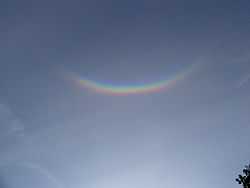Circumzenithal arc



The circumzenithal arc or circumzenith arc (CZA), also called the Bravais' arc, is an optical phenomenon similar in appearance to a rainbow; but it arises from refraction of sunlight through horizontally-oriented ice crystals, generally in cirrus clouds, rather than from raindrops. It forms no more than one-quarter of a circle centered on the zenith and on the same side as the sun. Its colors are from blue on the inside to red on the outside of the arc. It is one of the brightest and most colorful halos. Its colors are purer than those of the rainbow because there is much less color overlap in its formation. The first impression is that of an upside-down rainbow.
The circumzenithal arc has been called "a smile in the sky". It is rarely noticed because it occurs so far overhead. Cirrus clouds which cause a sun dog can cause a circumzenithal arc when they reach the zenith, if the Sun is low in the sky.
The light that forms the CZA enters an ice crystal through its flat top face, and exits through a side prism face. The refraction of almost parallel sunlight through what is essentially a 90-degree prism accounts for the wide color separation and the purity of color. The CZA can only form when the sun is at an altitude lower than 32.2°. The CZA is brightest when the sun is at 22° above the horizon, which causes sunlight to enter and exit the crystals at the minimum deviation angle; then it is also about 22° in radius, 3° in width. The CZA radius varies between 32.2° and 0° depending on the solar altitude. Towards either of the extremes it is vanishingly faint. When the sun is above 32.2°, light exits the crystals through the bottom face instead, to contribute to the almost colorless parhelic circle.
See also
| Wikimedia Commons has media related to Circumzenithal arc. |
References
- David K. Lynch and William Livingston. Color and Light in Nature. 2nd ed, 2004 printing.
- Les Cowley. "Circumzenithal Arc". Atmospheric optics. Retrieved 2007-04-23.
- Les Cowley. "CZA - Effect of solar altitude". Atmospheric Optics. Retrieved 2007-04-23.
External links
- Atmospheric Optics - About CZAs
- Atmospheric Optics - Circumzenithal Arc Gallery
- Circumzenithal arc over Rome, Italy
- Timelapse video of weak Circumzenithal Arc
- Physics of the circumzenithal arc
- Images from the UK by Crayford Manor House Astronomical Society
- Circumzenithal Arc Over Frisco, TX | 1-23-11 | Clouds 365 Project - Year 2